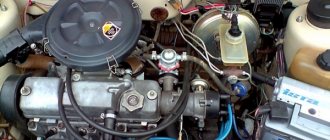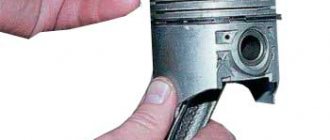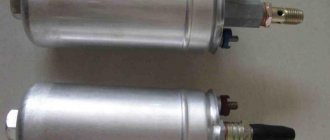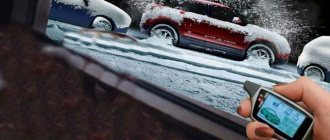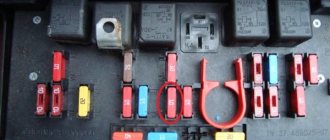Unfortunately, it is impossible to accurately answer the question of why the VAZ-2107 (carburetor) does not start, since there are many reasons for such a malfunction. This can be either a breakdown of a particular part or a failure of a certain system. If we ignore the possibility of a lack of fuel in the tank, then we can say that the car is faulty.
We start the car ourselves
If your VAZ-2107 does not start for the first time since you have been using it, you should not rush to go to a car service using a tow truck. Moreover, regardless of whether your car is fuel-injected or carburetor-powered, you can check for faults yourself. To do this, follow these steps:
- check the battery for functionality and charge level;
- look at the condition of fuel filters and spark plugs;
- Check the throttle valve for blockages.
If the results of the check show that all of the above parts are in working order, you need to continue checking, only this time do it in more depth.
Why are spark plugs black?
Normal spark plug
It is very important that during a planned replacement of spark plugs, the new spark plugs have the characteristics recommended by the manufacturer of this car brand. When installing the “wrong” spark plugs, you can spend a very long time looking for the causes of the malfunction, paying tidy sums to diagnosticians
Soot deposits on the spark plug
Causes:
- Rich air/fuel mixture
- Late ignition
The main symptoms are misfires, difficult engine starting, unstable engine operation and, as a result, increased vibrations.
First of all, check the air filter and replace it if necessary. If the car has a carburetor, check the fuel level in the float chamber. Check if these spark plugs are suitable for your car brand.
Oil deposits on the spark plug (electrodes and insulator are oily)
Causes:
- Oil entering the combustion chamber
The main symptoms are difficult starting, cylinder misfires, and jerking of the running engine.
Oil in the combustion chamber is a bad sign. But don’t despair, you might be able to get away with “a little bloodshed.” Oil can enter the combustion chamber in two ways - from below and from above. From above, oil can get from the cylinder head along the valve guides. The reason for this is oil-reflecting caps or, as they are also called, valve stem seals. In this case, you will only need to replace the caps; they are usually inexpensive and the replacement process is not very difficult. The second path of oil into the combustion chamber is through the “bottom”. That is, through the piston rings. In rare cases, “do-it-yourself engine decarbonization” helps. But in most cases, major repairs cannot be avoided.
causes:
- mismatch of the spark plug type recommended for the engine
- early ignition
- lean mixture
- air leak into the intake manifold
- engine cooling system malfunction
The insulator of the spark plug electrode becomes somewhat glossy, there are no deposits on the insulator and electrode, sometimes the electrodes are burnt. Check the spark plugs for compliance, adjust the ignition and carburetor (on carburetor engines). Check the system for air leaks. Check the engine cooling system.
Changing the color of the insulator
Causes:
- Incorrect spark plugs
The candle insulator becomes yellowish in color, just like when overheated, it is covered with “glaze”.
The temperature in the combustion chamber rises during sudden acceleration. Normal deposits become conductive. Hence the gaps in spark formation during sharp acceleration and high speeds.
Install new spark plugs.
Bridge between electrodes on spark plugs
Causes:
- Factory defective spark plugs
- Spark plugs have poor “self-cleaning”
Deposits from the combustion chamber fall between the electrodes. “Heavy” deposits collect in the gap between the electrodes and form a “bridge”. Because of this, the spark plug stops working - sparking does not occur. Accordingly, the entire cylinder is switched off from engine operation.
Engine troubles, increased fuel consumption. Strong smell of fuel from the exhaust system (unburned fuel is thrown out) Find the faulty spark plug and replace it. You can simply clean the deposits, but this is a temporary measure.
Ash deposits on spark plugs
Causes:
- Bad fuel
- Oil entering the combustion chamber
The center and side electrodes become covered with light brown deposits that come from oil or gasoline additives. If there are too many deposits, they cover the electrode with a crust. This leads to insulation of the electrodes, resulting in missed sparking and interruptions during acceleration. If excessive deposits form in a short time or with low mileage, check the valve stem seals. This will prevent oil from entering the combustion chamber. But most often, the cause is low-quality fuel. Try changing the gas station.
Wear of spark plug electrodes
Causes:
- Natural wear of spark plugs
The electrodes of the spark plug seem to be rounded, there are small deposits on them. The color is normal.
Worn spark plugs can make it difficult to start your engine in cold weather. Fuel consumption also increases.
Replace spark plugs.
Carbon deposits (spotty deposits) on the spark plug insulator
Causes:
- After proper adjustment, carbon deposits deposited in the combustion chamber begin to burn out and, at high engine speeds, come off the piston and stick to the spark plug insulator, causing occasional misfires in its operation.
The spark plugs need to be cleaned or replaced with new ones.
Possible reasons why the VAZ-2107 does not start
If your VAZ-2107 car starts, but not immediately, or does not start at all, this severely limits your capabilities and also disrupts your plans for the day. The fact is that even if your car does start, there is no guarantee that you will be able to drive it to your destination. By the way, it is precisely such situations that often arise due to the fact that the owner of the car does not change its consumables in a timely manner. Now let's look at the possible reasons why the VAZ-2107 may not start.
- Even if during the previous check you were convinced that the car’s battery is charged, you need to pay attention to its performance. Remember, there should be no traces of drips or rust on it.
- You should carefully inspect the fuses. There may have been a power surge in the car that caused them to fail.
- Check the functionality of the ignition switch. If traces of rust are found on it, it is likely that they are the reason that the car will not start.
- It is likely that the ignition coil has failed. Only replacing it will help correct this damage.
- The vehicle's fuel system could also fail.
- There may be too much condensation accumulated under the hood of your car.
Ignition system malfunctions
If the engine has trouble starting hot or cold, one possible problem may be intermittent sparking. Checking the serviceability of the ignition system includes the following operations:
- Inspection of spark plugs, high-voltage wires, distributor, ignition coil and other elements.
- Checking their installation correctly.
- Monitoring the state of the breaker contacts, the size of the gap between them and the ignition timing.
- Checking the functionality of the ignition system as a whole.
This operation is performed together with an assistant, whose task is to turn on the ignition and try to start the engine. In the meantime, the driver removes the high-voltage wire from one of the spark plugs and puts it on a cold spare part. It must be pressed tightly against any metal part of the engine and a test run must be performed.
A spark should jump between the spark plug contacts. A working ignition system ensures trouble-free operation of the VAZ 2107 engine in all modes. Next in line are the carburetor and the fuel pump, on the proper functioning of which the correct mixture formation depends.
Things to remember
Undoubtedly, it is the failure of the starter that is the most common breakdown that leads to the VAZ-2107 not starting. This is far from the worst problem, which, by the way, also occurs on higher-quality foreign cars.
To eliminate this malfunction, the starter should be removed, inspected for damage, and thoroughly cleaned of any deposits accumulated on it. A lubricant change will also be required.
Probable Causes
If the car starts poorly or takes a long time (after several attempts), the problem is most likely in the gasoline pump. In this situation, it should be recalled that even when the working engine is turned off, pressure is maintained in the fuel supply system. This is ensured by check valves located in the pump. However, if one of them does not work properly - after turning off the power plant, the pressure drops quite quickly.
In addition, this type of malfunction also occurs due to a breakdown of the fuel pressure regulator. As a result, at the moment when the crankshaft begins to rotate after activation of the starter, the motor does not react, since it needs time to build up pressure. It is for this reason that the engine does not start immediately.
Sometimes a hot car won't start at all. First of all, you should suspect a violation of the integrity of the wiring. If there is insufficient voltage, the starter simply will not be able to work. Here, most likely, you will need to replace the relay in it.
Checking the fuel pump
The part in question has a relatively simple structure. Rotation is carried out using a special pusher driven by a long steel rod. You can check the pumpless pump without removing it from the engine:
- you should remove the fuel pipe from the filter installed after the pump or disconnect the line in another place accessible for clear viewing;
- Then, using a special pedal, you need to pump the fuel.
The back of the part is equipped with a special lever. If you start pumping it, then gasoline should start flowing through the fuel line. Its absence indicates a malfunction. In this case, the easiest way is to purchase a new fuel pump. Its cost is no more than 1 thousand rubles. It is also possible to carry out repairs - but the cost is comparable to buying a new part.
HBO for cars
A hot engine can also cause a breakdown in the case of an installed gas system. Since driving on gas has recently become profitable, many drivers switched to this type of fuel, however, they did not take into account some of the nuances of the new system. In hot weather, gas expands more, which leads to increased pressure inside the system and often causes damage. This is why it is bad to drive on gas in the heat.
The result is an extremely dangerous situation. To avoid this, try not to fill the tank to full gas in the summer, this will reduce the pressure in the system and the risk of breakdown. If a similar problem occurs, it is recommended to let the car cool down and then visit a service station. You should not repair the gas system yourself; the equipment should be adjusted by a specialist.
Bad fuel as a possible problem
When you fill up with low-quality gasoline or diesel fuel, you shouldn’t be surprised why the engine doesn’t start well when it’s hot. Fuel is the most common cause of poor engine starting. This is easy to check. Just remove all the fuel and fill it with new, better quality. If you previously refueled with A92 gasoline, then you can try filling it with A98 and see how the car behaves. In the case of diesel fuel, you need to change the gas station and choose a more reliable seller.
The following problems may occur with the motor:
- There is a high content of additives in the fuel, which are poorly accepted by the engine.
- It is difficult for the pump to pump the required volume of fuel due to clogged filters.
- Engine control settings are lost. Inaccurate operation of the air mixture supply is also possible.
- The idle air valve and mass air flow sensor may be the culprit.
- Features of the operation of carburetor engines. If they are too hot, they have trouble starting.
The last point does not apply to injection engines. It’s just that carburetor engines have such a feature that they don’t start well when hot. This is due to the fact that the carburetor heats up to a very high temperature. Gasoline evaporates under the influence of temperature and fills the carburetor chambers and tubes as gas. In this case, the float chamber remains empty. And if you start the engine 5 minutes after stopping the engine, you may encounter a problem starting it, because... there will be no liquid fuel in the combustion chambers. This is normal, and this problem can be solved either by manually pumping fuel or by several attempts to start the engine. In injection power plants, this problem is eliminated, because there the fuel is delivered to the combustion chambers directly from the main line.
Problems starting an injection engine
The last cars to roll off the assembly line were equipped with fuel injection systems. The design of these is somewhat more complicated than carburetor ones. But there can be only 2 reasons for the malfunction:
- weak or absent spark;
- lack of fuel supply.
It is also important to measure the compression - this is often where the problem lies. You will need to purchase a special pressure gauge. The presence of an automatic diagnostic system greatly simplifies troubleshooting. Check Engine solves many problems. It lights up when a malfunction occurs. In 90% of cases, if it is impossible to start the engine, the error code begins in ROZXX.
The presence of such an error indicates missed “flashes” in the cylinders. If one is detected, you should check whether there is a spark or not. There are many diagnostic methods. For an ordinary driver who does not have his own workshop with all the necessary equipment, the following are suitable:
- using a diagnostic scanner;
- checking the ignition module.
Carburetor car engine starts and stalls
Symptoms of a problem
There is no fuel in the float chamber
Pump it up using the manual pump lever on the fuel pump.
The fuel pump or power system may be faulty. Remove the hose from the carburetor fuel supply fitting and press the manual primer lever on the fuel pump several times. A strong pulsating stream of gasoline should come out of the hose hole. If it is missing or weak, check the fuel pump or power system.
The strainer at the carburetor inlet is clogged
Remove it by unscrewing the cap, clean it (you can use a toothbrush), rinse with acetone or gasoline and blow with compressed air. At the same time, clean the filter seat in the carburetor cover.
The solenoid valve is faulty or the fuel jet of the idle system is clogged
Check whether the solenoid valve or the idle air system fuel nozzle holder has become loose due to any circumstances. Turn it on. Remove the wire from the valve and then put it back on. You should hear the click of the valve being activated. If it is not there, we connect a piece of wire plus the battery and the valve outlet. There is no click - we change the valve. There is a click - we check the EPH system.
Check the serviceability of the valve itself by unscrewing it from the carburetor and removing the fuel jet from it. The jet should be carefully inspected for contamination and deformation. We also check the ease of movement of the valve shut-off needle, the presence and integrity of the rubber O-ring on the valve body.
Unscrew the idle air system fuel nozzle holder (on carburetors with a holder instead of a solenoid valve), rinse, clean the fuel nozzle and blow with compressed air.
“Suction” of foreign air into the carburetor
In this case, the fuel mixture is lean. If the engine starts and immediately stalls, it is most likely very lean. The image shows probable places where foreign air is “sucked in” on the 2108 Solex carburetor.
Read more about the “suction” of foreign air in the article “Suction of foreign air into the carburetor.”
Disassemble the starter housing and replace the diaphragm with a new one. Adjust the starting device.
It is necessary to remove the carburetor cover, unscrew the jets, remove the tubes, rinse and clean them, clean the wells, blow everything out with compressed air and put it back. The image shows what should be cleaned on the carburetor 2105, 2107 Ozone.
On the Solex carburetor, unscrew the air jets and take them out along with the emulsion tubes. At the bottom of the opened wells there are fuel jets. We turn them out with a thin long slotted screwdriver. Clean, rinse with acetone and blow with compressed air.
Fuel and air jets and idle system channels are clogged
Unscrew the jets, rinse and clean them, and blow them with compressed air.
You can try to clean the idle system without disassembling the carburetor. Here is an article on this topic “Cleaning the idle system of the carburetor 2108, 21081, 21083 Solex.”
The fuel level in the carburetor float chamber is broken
The fuel mixture is either very lean or very rich due to incorrect adjustment.
Articles on the site about adjusting the fuel level:
The carburetor air damper drive is not adjusted (“choke”)
A not fully open air damper causes the fuel mixture to become richer in some cases to such an extent that it is difficult to start the engine, especially when it is hot. The spark plugs may become flooded with fuel. Adjust the drive:
With the choke handle fully extended, the air damper should completely cover the cross-section of the first chamber of the carburetor.
With the handle fully recessed, the air damper should be strictly vertical.
Notes and additions
— Before searching for the reasons that a carburetor engine starts and stalls, it is recommended to check the serviceability of the ignition system, since the symptoms of its malfunction are similar to the symptoms of a malfunction of the ignition system and the presence of fuel supply through the power system.
TWOKARBURATORS VK -More information on this topic in our VKontakte group TWOKARBURATORS DZ -and in Yandex Zen
Further exploration of electronics
In search of the reason why the VAZ-2107 does not start, it is necessary to further examine the electronics. If the issue is not the center wire ignition spark, you will need to remove the distributor cap. It is necessary to visually assess its internal state.
If dirt or condensation has accumulated under the distribution cover, the spark may not go where it should. To eliminate such violations, this space should be washed, dried and cleaned. The distributor contacts are also cleaned with fine sandpaper. If there is a dark mark on the slider or cover from an electrical shock, the part will need to be replaced.
Next, you should very carefully examine the wires going to the spark plugs. Their tips and all communications must be clean and dry. After this, the cover can be installed in its original place. The system is checked again. If all is unsuccessful, turn the candles out and clean them. Sometimes they will need to be replaced altogether.

